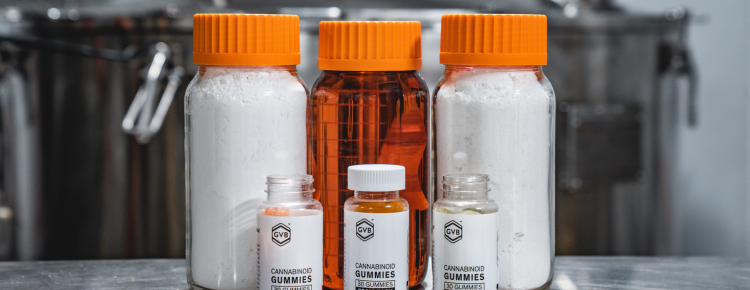Just like humans, most pets are equipped with endogenous systems designed to handle cannabinoids. That doesn’t mean, though, that CBD products for pets and humans are exactly the same.
In most cases, there’s no danger in using a CBD product that isn’t explicitly designed for your species. Man and beast alike, though, both benefit from using the products that are best for them. In this guide, learn the differences between CBD products made for pets and humans, and find out how to correctly determine CBD dosage in any animal.
CBD use in mammals
As a class of animals, all mammals are equipped with endocannabinoid systems. This is an endogenous system of neuroreceptors and signaling compounds that mainly processes body-generated, cannabinoid-like substances like anandamide¹.
When mammals ingest cannabinoids, their endocannabinoid systems are activated, leading to a relatively typical response across species. Of course, peculiarities of biology vary between mammals, leading to commensurately varied responses. Overall, though, all mammals are equipped with roughly similar systems for handling cannabinoids, usually making it acceptable to share these unique cannabis compounds with pets.
CBD use in humans
The safety² and basic usage parameters³ of CBD in humans are now reasonably well understood. Scientists have been gathering evidence regarding the usefulness of CBD in humans for more than 70 years, and this research has accelerated massively in the era of the online CBD industry.
Put simply, most people can tolerate reasonable doses of CBD reasonably well. Initial research indicates that CBD remains well-tolerated in excess of 1500mg per day, which is the average dose contained in an entire CBD tincture product.
Overall, CBD usage in humans does not appear to pose any considerable danger, and it may offer impressive benefits. Our understanding of the usefulness of CBD in humans has helped us better understand how this substance might also be of use in other animals.
CBD use in pets
Noting the effectiveness they experienced when using CBD, owners began giving CBD to their pets. Almost immediately, hundreds of pet owners took to social media and product review pages to rave about the incredible results they’d witnessed in their animals.
Dogs with anxiety could now be left alone, remaining relaxed when their owners returned home. Neurotic cats would finally leave heat spots alone. Some pets even seemingly defied serious illnesses, securing markedly improved quality of life.
Not all pets react to CBD the same, however, and all pets handle CBD at least a little bit differently than humans.
CBD use in non-mammal animals
Cannabis researchers have concluded that some form of an endocannabinoid system exists in every animal on earth except insects and protozoa⁴. This means birds, lizards, and even fish have endocannabinoid systems that might be impacted by CBD usage. The overall physiology of non-mammal animals is so different, however, that it would be prudent to consult with a veterinarian before going any further.
Types of CBD products for humans
The human-oriented face of the CBD industry has recently consolidated into a handful of popular product types. Alongside tinctures and capsules, which have always enjoyed roughly the same degree of relative popularity, CBD shoppers have welcomed edibles like gummies and topicals like lotions or salves. We’ll discuss each of the major types of CBD products used with humans below:
Tinctures
Also known as CBD oils, CBD tinctures are the original products — they’re what made CBD popular, and they still serve as the backbone of the modern hemp industry. Shoppers love the simplicity of ingredients and pinpoint dosing offered by tinctures.
Topicals
CBD topicals have primarily become popular among two groups of customers — people managing chronic pain and those focused on preserving beauty or preventing aging. Over the last decade, chronic pain sufferers have looked on with guarded hope as thousands of testimonials to the pain-fighting efficacy of CBD appeared online.
More recently, the apparent antioxidant benefits of CBD have attracted the attention of beauty-focused individuals as well. CBD facial serums and moisturizers have proliferated particularly well, and while sometimes admittedly overpriced, cannabinoid-infused cosmetic products appear to have genuine benefits.
Edibles
In recent years, CBD edibles like gummies have shot ahead to become some of the most popular online cannabinoid products. It’s unclear why it took so long for this product category to reach its full potential, but whatever the case may be, shoppers now flock to the delicious convenience of CBD gummies and similar edibles, which cover up the taste of hemp oil while also making every dose of cannabinoids into a sweet treat.
Capsules
CBD capsules remain popular even though gummies now also present a viable alternative to tinctures. For some, the advantages of CBD capsules remain unassailed: The ingredients are as simple as possible, there are no spikes in blood sugar to worry about, and taking CBD is just as easy as taking any other daily pill. Cannabinoid capsules are nothing fancy, but that’s precisely the point.
Inhalants
There are two primary ways that people inhale CBD: vaping and smoking. Vaping is when you vaporize cannabinoids before inhalation with a device such as a vape cartridge or disposable vape pen. Smoking is a more-familiar practice that involves fully incinerating cannabinoid-bearing plant material prior to inhalation. Noting that both methods of using cannabinoids are currently untested.
Types of CBD products for pets
Now that we’ve covered the primary ways humans use CBD, it’s time to turn to the methods chosen for their pets;
Tinctures
Just as is the case with humans, tinctures are the most popular CBD product given to pets. This approach might seem like quite the undertaking, but owners have developed a variety of ways to give pets tinctures orally:
- Simply holding the mouth and facilitating swallowing
- Adding the tincture to food
- Allowing it to absorb into a treat
- Dosing the dog while asleep
Topicals
Pets are like humans in that some conditions are best treated topically. In the case of heat spots, for instance, some owners apply CBD lotions or salves directly to the affected area. Of course, applying CBD topicals becomes much more difficult in situations where fur is still present.
Treats
Humans have edibles, pets have treats. CBD-infused dog treats are all the rage among owners these days, and CBD treats for cats are also catching on. Chances are that if there’s a pet, there’s a CBD product that has been designed with its species in mind.
Infused toys
If you look hard enough, you’ll come across CBD-infused chew toys for dogs sold online. These products are invariably of questionable quality and safety, though, and serve more of a novelty function rather than providing any genuine value. It is advised to consult with a veterinarian prior to giving this product to your pet.
CBD dosage in humans
Giving CBD to humans and pets isn’t exactly the same. Below, we’ll start by taking a look at proper dosing considerations in humans and then move on to pets.
Average dosing by weight
There is no universally determined ideal daily dose of CBD by weight. It has been suggested, though, that a daily range of 1-50mg/kg (milligrams-per-kilograms) of CBD is acceptable with an ideal daily range sitting somewhere closer to the 1-3mg/kg mark.
For context, an average adult male weighs around 60kg and a female weighs around 50kg. As a result, an ideal daily dose of CBD in males may range anywhere from 60-180mg while an ideal dose in women would be 50-150mg. Keep in mind that it appears this recommendation can normally be exceeded by at least ten times without noticing any significant deleterious effects.
Special considerations
When determining ideal CBD dosing in humans, conflicts with other substances and medications must be kept in mind. While not usually dangerous, CBD competes for enzymes used to metabolize many common drugs — usually drugs that come with a “grapefruit warning.”
If using drugs that conflict with CBD, lower doses may be recommended, or it may be recommended that CBD not be used at all. Human users of CBD should seek medical consultation before and while using the cannabinoid.
CBD dosage in pets
CBD dosing in pets is more difficult to determine specifically given the vast differences between domesticated animal species. We can discuss generally, though, the considerations that should be taken when determining CBD dosing in animals.
Average dosing by weight
Very little research has been conducted into ideal CBD dosing in animals, but one study⁵ in dogs and cats concluded that daily doses of 2mg/kg might be appropriate. Given the smaller size of most pets compared to humans, the overall daily dose will be much smaller.
At 2mg/kg, for instance, the average cat (4kg) would only need 8mg CBD per day. A small dog (10kg) would need 20mg, a medium dog (20kg) would need 40mg, and a large dog (30kg+) would need 60mg or more daily.
Special considerations
The physiology of each pet kept by humans is different. Products or usage recommendations that hold true for one pet should not be assumed to also be true for a pet of a different species or even of a different breed.
It is highly recommended that owners consult with a trusted veterinarian before choosing a CBD product or establishing a dosage schedule for their pets. Professional assistance may be even more useful in this regard than it is when determining accurate CBD dosing in humans.
Pet & human CBD: More similar than different
For the average, skeptical consumer, two questions come to mind when confronted with the idea of giving CBD to their pets. One, is this just a fad or gimmick? And two, how do I know that giving my pet CBD is safe?
It’s a fundamental truth that human biology differs from animal biology. Even given the massive differences in the way these genes are expressed, though, there’s hardly any difference between the genetic codes of most animals on Earth.
The fact that we all have endocannabinoid systems should make us feel closer to our furry, feathery, and even scaly friends. Human beings may have been the ones to discover CBD, but it’s pertinent that we extend the potential benefits of this compound to our fellow animals, now that the knowledge about its effects is widely available.
Sources
1. Scherma, M., Masia, P., Satta, V., Fratta, W., Fadda, P., & Tanda, G. (2019). Brain activity of anandamide: a rewarding bliss? Acta Pharmacologica Sinica, 40(3), 309–323. https://doi.org/10.1038/s41401-018-0075-x
2. Larsen, C. P., & Shahinas, J. (2020b). Dosage, Efficacy and Safety of Cannabidiol Administration in Adults: A Systematic Review of Human Trials. Journal of Clinical Medicine Research, 12(3), 129–141. https://doi.org/10.14740/jocmr4090
3. Argueta, D. A., Ventura, C. M., Kiven, S. B., Sagi, V., & Gupta, K. (2020). A Balanced Approach for Cannabidiol Use in Chronic Pain. Frontiers in Pharmacology, 11. https://doi.org/10.3389/fphar.2020.00561
4. Silver, R. M. (2019). The Endocannabinoid System of Animals. Animals, 9(9), 686. https://doi.org/10.3390/ani9090686
5. Deabold, K. A., Schwark, W. S., Wolf, L. A., & Wakshlag, J. J. (2019). Single-Dose Pharmacokinetics and Preliminary Safety Assessment with Use of CBD-Rich Hemp Nutraceutical in Healthy Dogs and Cats. Animals, 9(10), 832. https://doi.org/10.3390/ani9100832





